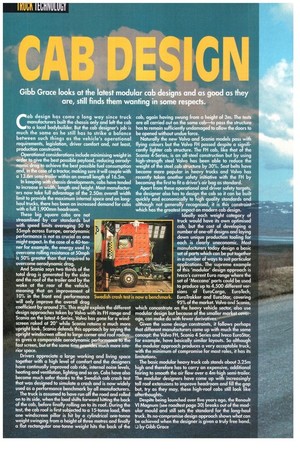CAB DES Ghl
Page 46

If you've noticed an error in this article please click here to report it so we can fix it.
Gibb Grace looks at the latest modular cab designs and as good as they are, still finds them wanting in some respects.
Cab design has come a long way since truck manufacturers built the chassis only and left the cab to a local bodybuilder. But the cab designer's job is much the same as he still has to strike a balance between such things as the vehicle's operational requirements, legislation, driver comfort anal, not least, production constraints.
Operational considerations include minimising weight in order to give the best possible payload, reducing aerodynamic drag to achieve the best possible fuel consumption and, in the case of a tractor, making sure it will couple with a 13.6m semi-trailer within on overall length of 16.5m. In keeping with chassis developments, cabs have tended to increase in width, length and height. Most manufacturers now take full advantage of the 2.50m overall width limit to provide the maximum internal space and on longhaul trucks, there has been an increased demand for cabs with a full 1,900mm headroom.
These big square cabs are not streamlined by car standards but with speed limits averaging 50 to 55mph across Europe, aerodynamic performance is not as crucial as one might expect. In the case of a 40-tanner for example, the energy used to overcome rolling resistance at 50mph is 50% greater than that required to overcome aerodynamic drag. And Scania says two thirds of the total drag is generated by the sides and the roof of the trailer and by the wake at the rear of the vehicle, meaning that an improvement of 10% in the front end performance will only improve the overall drag coefficient by around 3%. This might explain the different design approaches taken by Volvo with its FH range and Scania on the latest 4-Series. Volvo has gone for a windscreen raked at 20' while Scania retains a much more upright look. Scania defends this approach by saying the upright windscreen allied to large corner and roof radiuses gives a comparable aerodynamic performance to the fast screen, but at the same time provides much more interior space.
Drivers appreciate a large working and living space together with a high level of comfort and the designers have continually improved cab ride, internal noise levels, heating and ventilation, lighting and so on. Cabs have also become much safer thanks to the Swedish cab crash test that was designed to simulate a crash and is now widely used as a performance benchmark by all manufacturers. The truck is assumed to have run off the road and rolled on to its side, when the load shifts forward hitting the back of the cab, before finally rolling on to its roof. During the test, the cab roof is first subjected to a 15-tonne load, then one windscreen pillar is hit by a cylindrical one-tonne weight swinging from a height of three metres and finally a flat rectangular one-tonne weight hits the back of the
cab, again having swung from a height of 3m. The tests are all carried out on the same cab—to pass the structure has to remain sufficiently undamaged 110 allow the doors to be opened without undue force.
Naturally the new Volvo and Scania models pass with flying colours but the Volvo FH passed despite a significantly lighter cab structure. The FH cab, like that of the Scania 4-Series, is an all-steel construction but by using high-strength steel Volvo has been able to reduce the weight of the steel cab structure by 30%. Seat belts have become more popular in heavy trucks and Volvo has recently taken another safety initiative with the FH by becoming the first to fit a driver's air bag as standard. Apart from these operational and driver safety targets, the designer also has to design the cab so it can be built quickly and economically to high quality standards and although not generally recognised, it is this constraint which has the greatest impact on modern cab design. Ideally each weight category of truck would have its own optimised cab, but the cost of developing a number of one-off designs and laying down unique production tooling for each is clearly uneconomic. Most manufacturers today design a basic set of parts which can be put together in a number of ways to suit particular applications. The supreme example of this 'modular' design approach is Iveco's current Euro range where the set of 'Mecca no' parts could be used to produce up to 4,500 different versions of EuroCargo, EuroTeth, EuroTrakker and EuroStar, covering 95% of the market. Volvo and Scania, which concentrate on the heavy vehicle sector, also use modular design but because of the smaller market coverage, can make do with fewer derivatives. Given the same design constraints, it follows perhaps that different manufacturers come up with much the same concept the Volvo FH, Scania 4 Series and Iveco EuroStar, for example, have basically similar layouts. So although the modular approach produces a very acceptable truck, with the minimum of compromise for most roles, it has its limitations.
The basic modular heavy truck cab stands about 3.25m high and therefore has to carry an expensive, additional fairing to smooth the air flow over a 4m-high semi-trailer. The modular designers have come up with increasingly tall roof extensions to improve headroom and fill the gap but, try as they may, these high-roof cabs still look like afterthoughts. Despite being launched over five years ago, the Renault VI Magnum (see roadtest page 30) breaks out of the modular mould and still sets the standard for the long-haul truck. Its no-compromise design approach shows what can be achieved when the designer is given a truly free hand. Li by Gibb Grace












































































































